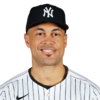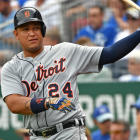Miguel Cabrera is next to 600 homers, and here's who else has a legitimate shot
Albert Pujols just blasted his 600th career homer, so it's time to look at who could join him in the club

Albert Pujols of the Los Angeles Angels of Anaheim hit a grand slam Saturday night off Ervin Santana of the Twins to reach the 600-home run threshold for his career. He's the ninth player in the history of Major League Baseball to join the 600-homer club.
The next player's entrance into the club seems almost as certain as Pujols' was -- that's because Detroit Tigers first baseman Miguel Cabrera (149 away) is one of the few who can rival the machine-like consistency that propelled Pujols to such heights. But who will join after that?
Let's take a look at seven of the potential candidates, accepting that many of the players closest to 600 (Adrian Beltre included) are unlikely to reach the mark before retirement beckons.
Ryan Braun's inclusion is an exercise in why others, like Adrian Beltre and Edwin Encarnacion, were excluded.
A healthy Braun exhibits the rhythmic dependency required to reach 600 home runs. He has had nine seasons with more than 300 plate appearances, and he has homered at least 25 times in all but one of them. The catch, besides Braun being in his age-33 season, is that he's had some injury issues in recent years. Heck, he's currently on the disabled list. If Braun can average 25 home runs per season over the rest of his contract -- and he's guaranteed employment through the 2020 season -- he'll be knocking on the door of 400 as he enters his age-37 season.
Is it likely that Braun could hit 200 more after that point? Let's put it this way: the player with the most home runs after turning 37 is far and away Barry Bonds. Bonds hit 195.
There are three ways to get onto lists like these: hitting lots of home runs; being super young; and hitting lots of home runs while being super young.
Justin Upton's inclusion is due to his youth. He has heretofore enjoyed just two 30-homer seasons, yet he has the most home runs of any player younger than 30. Alas, age can't be your only hustle. Upton will find that out the hard way in August, when he celebrates his 30th birthday. Once Upton does that, he'll have the second-most home runs by a player aged 30 or younger … behind Jay Bruce.
Maybe Upton's next decade sees him crank up his power more often. From here, however, it's hard to see him reaching 600.
Speaking of youngsters that can mash ….
Giancarlo Stanton won't turn 30 until after the 2019 season. Unfortunately, his unreliability makes him tough to project. Remember, Stanton has played in more than 130 games just twice in his career, and he's yet to pop 40 homers in a season. All he has to do is average 30 home runs from 2017-19 to enter his 30s around the halfway point.
Still, how often does a player get healthier the older he gets? If Stanton can, he has a legitimate shot at joining the 600-homer club some day.
You can't write this kind of piece without including Trout. Even though he's going to miss close to two months recovering from a torn thumb ligament, there's a chance he ends the year with 200 home runs. One more typical Trout season as a 26-year-old, and he'll be looking at somewhere around 230-240 home runs entering his statistical prime.
Of course Trout is a candidate to reach 600. He's probably the best candidate, honestly, because he's the best candidate for roughly every historical feat.
We're lumping these two together because they're in the same boat. Both are young and extremely talented, and both have real shots at 600 home runs.
Bryce Harper is more than three months younger and has a 21-homer lead, so he has the better case. He's already had a 40-homer season, and could threaten that mark again this year, depending on whether he can avoid injury (and/or further suspension). He won't turn 25 until October, at which point he should be over 150. That's not an Alex Rodriguez (241), Pujols (201), or even Andruw Jones (185) amount, but it's a good start.
Another 35-to-37-homer effort from Manny Machado would give him roughly the same math. Neither is a given, but both have the chance to make strong pushes over the next 12 to 15 years.
From a pair of not-yet 25-year-olds to someone who turned 25 in January.
For Kris Bryant to threaten 600, he'd have to continuously swat 40 or more homers over the next decade-plus. The good news is Bryant has the kind of power to do just that. The bad news is Bryant seems unlikely to reach 600. Oh well.































